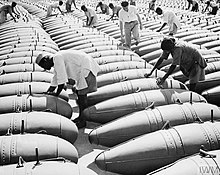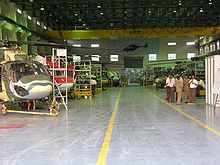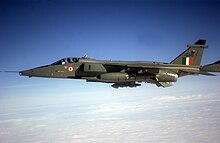
The Indian Air Force (IAF) is the air arm of the Indian Armed Forces. Its primary mission is to secure Indian airspace and to conduct aerial warfare during armed conflicts. It was officially established on 8 October 1932 as an auxiliary air force of the British Empire which honoured India's aviation service during World War II with the prefix Royal. After India gained independence from United Kingdom in 1947, the name Royal Indian Air Force was kept and served in the name of the Dominion of India. With the transition to a republic in 1950, the prefix Royal was removed.

The HAL Tejas is an Indian single-engine, 4.5 generation delta wing multirole combat aircraft designed by the Aeronautical Development Agency (ADA) and manufactured by Hindustan Aeronautics Limited (HAL) for the Indian Air Force (IAF) and Indian Navy. Tejas made its first flight in 2001 and entered into service with the IAF in 2015. In 2003, the aircraft was officially named "Tejas". Currently Tejas is the smallest and lightest in its class of supersonic combat aircraft.

The HAL Dhruv is a utility helicopter designed and developed by Hindustan Aeronautics Limited (HAL) in November 1984. The helicopter first flew in 1992; its development was prolonged due to multiple factors including the Indian Army's requirement for design changes, budget restrictions, and sanctions placed on India following the 1998 Pokhran-II nuclear tests. The name comes from a Sanskrit origin word dhruv which means unshakeable or firm.

The HAL HF-24 Marut was an Indian jet fighter aircraft developed and manufactured by Hindustan Aeronautics Limited (HAL) during the 1960s and early 70s. The Marut was designed by the German aeronautical engineer Kurt Tank, with the Project Engineer being George William Benjamin. The aircraft was the first Indian-developed jet fighter and the first in Asia, outside the Soviet Union, to go beyond the test phase and into serial production and active service. On 17 June 1961, the type conducted its maiden flight; on 1 April 1967, the first production Marut was officially delivered to the IAF.
Aero India is a biennial air show and aviation exhibition held in Bengaluru, India, at the Yelahanka Air Force Station. It is organised by the Defence Exhibition Organisation, Ministry of Defence.
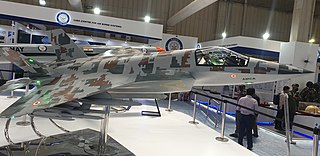
The Advanced Medium Combat Aircraft (AMCA) is an Indian single-seat, twin-engine, all-weather fifth-generation stealth, multirole combat aircraft being developed for the Indian Air Force and the Indian Navy. The Mark-1 variant of the aircraft will be a fifth generation fighter while the Mark-2 variant will have sixth-generation technologies. The aircraft is designed by the Aeronautical Development Agency (ADA) - an aircraft design agency under MoD. A Special Purpose Vehicle (SPV) consisting of ADA, Hindustan Aeronautics Limited (HAL) and a private company is being formed for the development and production of AMCA. In March 2024, the project received approval from India's Cabinet Committee on Security for the prototype development.

The Bristol Siddeley Orpheus is a single-spool turbojet developed by Bristol Siddeley for various light fighter/trainer applications such as the Folland Gnat and the Fiat G.91. Later, the Orpheus formed the core of the first Bristol Pegasus vectored thrust turbofan used in the Harrier family.

The GTRE GTX-35VS Kaveri is an afterburning turbofan project developed by the Gas Turbine Research Establishment (GTRE), a lab under the Defence Research and Development Organisation (DRDO) in Bengaluru, India. An Indian design, the Kaveri was originally intended to power production models of the HAL Tejas Light Combat Aircraft (LCA) developed by Hindustan Aeronautics Limited. However, the Kaveri programme failed to satisfy the necessary technical requirements or keep up with its envisaged timelines and was officially delinked from the Tejas programme in September 2008.
The PJSC United Aircraft Corporation (UAC) is a Russian aerospace and defense corporation. With a majority stake belonging to the Russian government, it consolidates Russian private and state-owned aircraft manufacturing companies and assets engaged in the manufacture, design and sale of military, civilian, transport, and unmanned aircraft. Its headquarters are in Krasnoselsky District, Central Administrative Okrug, Moscow.

The HAL Prachand is an Indian multi-role light attack helicopter designed and manufactured by Hindustan Aeronautics Limited (HAL) under Project LCH. It has been ordered by the Indian Air Force (IAF) and the Indian Army. Its flight ceiling is the highest among all attack helicopters.

HAL Aerospace Museum is India's first aerospace museum located at Hindustan Aeronautics Limited premises, in Bangalore. Established in 2001, the Museum is part of the HAL Heritage Centre and Aero Space Museum, and showcases the growth of the Indian aviation industry and HAL for six decades. The museum houses displays of various aircraft and helicopters, Aircraft engine models, Flight simulators, a mock Air Traffic Control Tower and exhibit of Indian aviation history. The Museum is maintained by HAL.
The Indian Air Force has been undergoing a modernization program to replace and upgrade outdated equipment since the late 1990s to meet modern standards. For that reason, it has started procuring and developing aircraft, weapons, associated technologies, and infrastructures. Some of these programs date back to the late 1980s. The primary focus of current modernization and upgrades is to replace aircraft purchased from the Soviet Union that currently form the backbone of the Air Force.
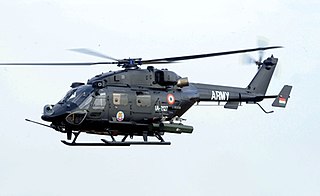
The HAL Rudra also known as ALH-WSI, is an armed version of the HAL Dhruv utility helicopter which is designed and produced by the Indian aerospace manufacturer Hindustan Aeronautics Limited (HAL).

Vishnu Madav Ghatage (1908–1991) was an Indian aeronautical engineer, known for his pioneering conceptual and engineering contributions to Indian aeronautics. He led the team which designed and developed HAL HT-2, the first Indian designed and built aircraft. He was honoured by the Government of India in 1965, with the award of Padma Shri, the fourth highest Indian civilian award for his services to the nation.

Uttam is a solid-state gallium arsenide (GaAs) based active electronically scanned array (AESA) radar under development by the Electronics and Radar Development Establishment (LRDE), a laboratory of the Indian Defence Research and Development Organisation (DRDO). It is a low probability of intercept radar. It is a liquid cooled AESA radar featuring quad band modules that can be stacked to form a larger unit. This allows the manufacturer to scale the radar to be used in larger aircraft.

The HAL Tejas Mark 2, or Medium Weight Fighter (MWF), is an Indian single-engine, canard delta wing, multirole combat aircraft designed by the Aeronautical Development Agency (ADA) in collaboration with Aircraft Research and Design Centre (ARDC) of Hindustan Aeronautics Limited (HAL) for the Indian Air Force (IAF). It is a further development of the HAL Tejas, with an elongated airframe, close coupled canards, new sensors, and a more powerful engine.

The HAL Twin Engine Deck Based Fighter (TEDBF) is a canard delta wing, twin-engine, carrier-based, multirole combat aircraft currently under development for the Indian Navy. The TEDBF is being designed and developed by the Aeronautical Development Agency (ADA), and will be manufactured by Hindustan Aeronautics Limited (HAL). The TEDBF is intended to perform a multitude of missions, including air supremacy, air interdiction, anti-access/area denial (A2/AD), anti-ship warfare (ASW) and electronic warfare (EW) missions. The TEDBF is expected to replace the Mikoyan MiG-29K onboard the INS Vikramaditya and the INS Vikrant.

HF-73 also known as Hindustan Fighter-73 was a proposed twin engine strike fighter intended to be operated by the Indian Air Force. It was a joint venture project undertaken by India's Hindustan Aeronautics Limited and Messerschmitt-Bölkow-Blohm (MBB) of West Germany in 1972. The proposed HF-73 strike fighter was similar in design and role to the multi-national European consortium Panavia Aircraft GmbH's Panavia Tornado. The project was cancelled in the late 1970s.
The INAS 323 is an Indian naval air squadron based at INS Hansa, Goa. It operates the multi-role helicopter HAL Dhruv in maritime configuration. The primary role of the squadron is Search and Rescue, Special Operations and Coastal Surveillance.

